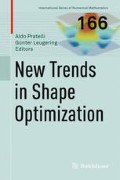Abstract
For a class of optimal partition problems involving the half-Laplacian operator and a subcritical cost functionals, we derive the optimal regularity of the density-functions which characterize the partitions, for the entire set of minimizers. We present a numerical scheme based on the arguments of the proof and we collect some numerical results related to the problem.
The research leading to these results has received funding from the European Research Council under the European Union’s Seventh Framework Programme (FP/2007-2013)/ERC Grant Agreement n. 321186: “Reaction-Diffusion Equations, Propagation and Modelling” held by Henri Berestycki, and under the European Union’s Seventh Framework Programme (FP/2007-2013)/ERC Grant Agreement no. 339958: “Complex Patterns for Strongly Interacting Dynamical Systems” held by Susanna Terracini.
Access this chapter
Tax calculation will be finalised at checkout
Purchases are for personal use only
References
B. Bourdin, D. Bucur, É. Oudet, Optimal partitions for eigenvalues. SIAM J. Sci. Comput. 31(6), 4100–4114 (2009/10)
X. Cabré, J. Tan, Positive solutions of nonlinear problems involving the square root of the Laplacian. Adv. Math. 224(5), 2052–2093 (2010)
L.A. Caffarelli, F.-H. Lin, Singularly perturbed elliptic systems and multi-valued harmonic functions with free boundaries. J. Am. Math. Soc. 21(3), 847–862 (2008)
L.A. Caffarelli, L. Silvestre, An extension problem related to the fractional Laplacian. Commun. Partial Differ. Equ. 32(7–9), 1245–1260 (2007)
L.A. Cafferelli, F.H. Lin, An optimal partition problem for eigenvalues. J. Sci. Comput. 31(1–2), 5–18 (2007)
S.-M. Chang, C.-S. Lin, T.-C. Lin, W.-W. Lin, Segregated nodal domains of two-dimensional multispecies Bose-Einstein condensates. Phys. D 196(3–4), 341–361 (2004)
G. Dal Maso, An Introduction to \(\;\Gamma \)-Convergence. Progress in Nonlinear Differential Equations and their Applications, vol. 8. (Birkhäuser Boston, Inc., Boston, 1993)
E. Di Nezza, G. Palatucci, E. Valdinoci, Hitchhiker’s guide to the fractional Sobolev spaces. Bull. Sci. Math. 136(5), 521–573 (2012)
N.S. Landkof, Foundations of Modern Potential Theory. (Springer, New York, 1972) Translated from the Russian by A.P. Doohovskoy, Die Grundlehrender mathematischen Wissenschaften, Band 180
B. Noris, H. Tavares, S. Terracini, G. Verzini, Uniform Hölder bounds for nonlinear Schrödinger systems with strong competition. Commun. Pure Appl. Math. 63(3), 267–302 (2010)
H. Tavares, S. Terracini, Regularity of the nodal set of segregated critical configurations under a weak reflection law. Calc. Var. Partial Differ. Equ. 45(3–4), 273–317 (2012)
S. Terracini, G. Verzini, A. Zilio, Uniform Hölder bounds for strongly competing systems involving the square root of the Laplacian. Preprint arXiv:1211.6087
S. Terracini, G. Verzini, A. Zilio, Uniform Hölder regularity with small exponent in competition-fractional diffusion systems. Discret. Contin. Dyn. Syst. 34(6), 2669–2691 (2014)
Acknowledgments
The author is indebted with the anonymous referee for suggesting many useful improvements to the original manuscript.
Author information
Authors and Affiliations
Corresponding author
Editor information
Editors and Affiliations
Appendix A: The Brezis-Kato Inequality
Appendix A: The Brezis-Kato Inequality
In this last section, we will give a proof of Corollary 2.7, using in fact the following version of the Brezis-Kato inequality
Lemma A.1
Let \(\Omega \subset \mathbb {R}^N\) be a smooth and bounded domain and let us consider \(\mathbf {u}\in H^{1/2}_\Omega (\mathbb {R}^N, \mathbb {R}^k)\) to be solutions to the system
where \(a_i \in L^N(\mathbb {R}^N)\). Then \(u_i \in L^\infty (\mathbb {R}^N)\) for all \(i = 1, \ldots , k\) and the norm can be bounded uniformly in \(\beta \) with a constant that depends only on the \(H^{1/2}\)-norm of \(\mathbf {u}\) and the \(L^N\)-norm of \(a_i\).
Remark A.2
In order to apply the previous result to the setting of Corollary 2.7, it is sufficient to introduce the functions
and to observe that, thanks to the sub-criticality of \(f_i\) and the uniform boundedness of Lagrange multipliers, we have \(\Vert a_{i,\beta }\Vert _{L^N(\mathbb {R}^N)} \le C \) uniformly in \(\beta \).
Proof
In order to simplify the proof, we resort to the extensional formulation of the half-Laplacian, relating the system (A.1) to
where \(v_i \in H^1(\mathbb {R}^{N+1}_+)\) satisfy \(v_i(\cdot , 0) = u_i\). Let \(g_\varepsilon \in \mathcal {C}^{\infty }(\mathbb {R})\) be a smooth approximation of the modulus functions, that is, \(g_\varepsilon (t) = \sqrt{\varepsilon +t^2}\). The Stampacchia’s lemma and the Lebesgue’s theorem ensure that
For any test function \(\phi \in H^1(\mathbb {R}^{N+1}_+)\) such that \(\phi \ge 0\), we have
and letting \(\varepsilon \rightarrow 0^+\) we obtain
(similar computations are present in [12, Lemma 5.5]). As a result, each \(|v_i| \in H^1(\mathbb {R}^{N+1}_+)\) is a subsolution of the equation in \(w_i \in H^1(\mathbb {R}^{N+1}_+)\)
Thus, if we show a uniform bound for the functions \(w_i\) in \(L^\infty \), by the comparison principle we could evince that the same bounds holds for the functions \(|v_i|\). To conclude it is then sufficient to recall the Brezis-Kato estimate for the half-Laplacian, shown in [2, Theorem 5.2], which implies the sought \(L^\infty \) bound. \(\square \)
Rights and permissions
Copyright information
© 2015 Springer International Publishing Switzerland
About this chapter
Cite this chapter
Zilio, A. (2015). Optimal Regularity Results Related to a Partition Problem Involving the Half-Laplacian. In: Pratelli, A., Leugering, G. (eds) New Trends in Shape Optimization. International Series of Numerical Mathematics, vol 166. Birkhäuser, Cham. https://doi.org/10.1007/978-3-319-17563-8_13
Download citation
DOI: https://doi.org/10.1007/978-3-319-17563-8_13
Published:
Publisher Name: Birkhäuser, Cham
Print ISBN: 978-3-319-17562-1
Online ISBN: 978-3-319-17563-8
eBook Packages: Mathematics and StatisticsMathematics and Statistics (R0)

